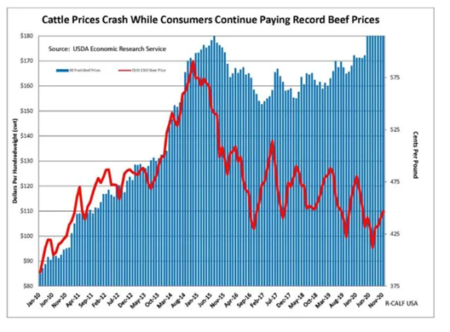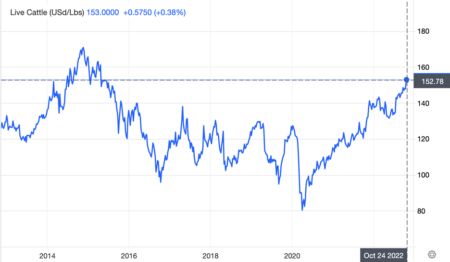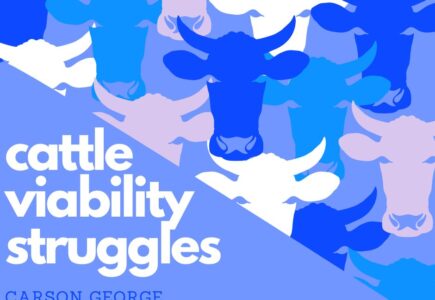By: Carson George
University of Saskatchewan Student
Since late 2014, the cost of ranching has been on the rise, making it very challenging for new ranchers to start up and for existing ranchers to expand their herds. As a young rancher myself, I have had to face the high entry costs and the challenges that come with this. But why are costs increasing? There are a few key reasons why the cost of running a viable ranch is a challenge which I will explain in this blog.
What’s the land situation?
In 2018, the value of farmland increased by an average of 7.4% in both Alberta and Saskatchewan, according to Farm Credit Canada’s Farmland Value Report. The rising cost of farmland has been a growing concern since before the change of the millennium. In fact, both Alberta and Saskatchewan’s value of farmland has risen by an average of 8.2% annually over the past 25 years making it hard for current ranchers to expand and up-and-coming ranchers to purchase land.
For those who are in the situation of inheriting land from family and may be able to inherit land at a lower land cost, it doesn’t exempt them from issues incurred from inheriting land over buying your ideal land for ranching. Today, most of the best farmland throughout the prairie is used for the production of grain since it offers a larger return on investment compared to pastureland. In response to the droughts experienced across the prairies in recent years, feed and water supply for cattle are decreasing, which also results in feed costs, such as those for hay, doubling. As climate volatility increases, it makes the more sustainable land more expensive. However, more farmland cannot be created, making end farmland valuable and useful.
What happened in 2014?
In 2014, the prices of beef and cattle began to diverge. Referring to the figure below, consumers have shown they are willing to purchase beef at all-time high prices, indicating that there is a huge demand for beef. Yet cattle prices are still low. As a result, customers are paying high prices, cattle producers are receiving low prices, and the meatpackers are making record-breaking profits. Just this year, “The Saskatchewan Stock Growers Association says it’s asking the provincial and federal governments to look into an imbalance between the price ranchers receive for the cattle and the price consumers pay at the meat counter. The group says many ranchers and feedlots are operating at a loss this year…but packers and retailers are reporting strong profits this year. As reported in the Canadian Press: “The Stock Growers say they believe slaughterhouses may be intentionally running fewer shifts in order to keep wholesale beef prices high and allow fed cattle supplies to build up in the countryside.”

The market functions best when price signals such as the prices for cattle and beef move in unison; expensive beef causes producers to sell more cattle, which lowers the price of beef. However, starting in late 2014, the opposite occurred: the price of the beef that meatpackers sold increased and the prices that those meatpackers paid to cow producers decreased. Despite demand, cattle producers are progressively leaving the market. Three meat processing facilities in Canada produce 85% of the country’s beef, enabling the meat packers to negotiate lower prices with nearby farmers to purchase cattle. As meatpackers are snatching up all the profits and raising costs for consumers, they in turn are forcing small, independent cattle ranchers out of business. This could ultimately lead to the potential destruction of our current food system, potentially making Canada more reliant on imported meat.
What are the challenges of cattle farming?
The main challenges that cattle farmers are facing are astronomical land prices, feed price increases, a drastic increase in equipment costs, and drought. All this while facing a market with very limited positive change. The problems begin when the selling price of cattle does not increase with demand. As ranchers are seeing the same amount of income and having to deal with inflation, there are only two options (see Fig 2.). Farmers either must start selling cattle to be able to provide for themselves and the rest of the herd or begin to purchase more land and feed for the herd. If things such as the drought, land price increases, feed price increases, and equipment price increases continue, ranchers will have to sell their cattle later.

What can farmers do to manage their herds?
There are a few options that up-and-coming ranchers can do to begin their ranch and for existing ranchers to expand. Farm advisors with Meyers Norris Penny (MNP) support all ranchers by providing mentorship advice and scholarships. Additionally, they provide a student program. MNP provides young ranchers with money to buy animals and sell them later to make money or help start a future ranch. There are more feasible options such as grazing animals on community pastures which allows for many farmers to use the land together and help break up the rental cost for everyone. Working off-farm jobs that can be done while ranching to help save money to support your future ranch. Lastly, traveling further distances to places where very few other ranchers are willing to go for cheaper land.
Nevertheless, there are many struggles in making a cattle operation viable. With some smart decisions, ranchers will be able to start their operations, existing farmers will be able to expand their herds, and cattle operations across the prairies can last for generations.
Reference:
- Allen, H. Atter. (2021) Desperate Prairie ranchers are selling cattle early amid drought, lack of feed, https://www.cbc.ca/news/canada/saskatchewan/cattle-drought-agriculture-industry-heat-1.6129876
- Melchior. (2019) The challenge of starting a cattle ranch from scratch, https://www.canadiancattlemen.ca/features/the-challenge-of-starting-a-cattle-ranch-from-scratch/
- M, Stoller (2021) Beef is Expensive. So Why Are Cattle Rancher Going Bankrupt? https://mattstoller.substack.com/p/beef-is-expensive-so-why-are-cattle
- Fikowski, R. White (2022) Is the spike in the price of beef hurting Alberta beef producers? https://calgary.ctvnews.ca/is-the-spike-in-the-price-of-beef-hurting-alberta-beef-producers-1.5989524
- The Canadian Press (2022) Ranchers call for investigation into meat pricing, https://globalnews.ca/news/8967819/meat-pricing-investigation-saskatchewan/\
- Edmiston, (2020) Three meat-packing plants turn out 85% of Canada’s beef. How did this happen? https://financialpost.com/commodities/agriculture/why-only-three-meat-packing-plants-process-the-vast-majority-of-canadas-beef
- Farming for Tomorrow, (2019) Prairie land values in 2070 https://farmingfortomorrow.ca/land-development/prairie-land-values-in-2070/
- Meyers Norris Penny, (2023) Agriculture https://www.mnp.ca/en/clients/agriculture
Carson George

My name is Carson George, I am 21 years old I live on a family farm/ranch outside of Kenaston Saskatchewan. I have completed my Agronomy Diploma at the University of Saskatchewan and am currently taking my second year of Agriculture business degree from the University of Saskatchewan I plan to graduate in the spring of 2024. The past summer and this upcoming summer I have a summer job as a research assistant at Corteva Agriscience in Saskatoon. I have also started my own farm and ranch along with helping my dad with his farm and ranch in my free time. My other Hobbies include playing Hockey, Basketball, Golf, and baseball.

